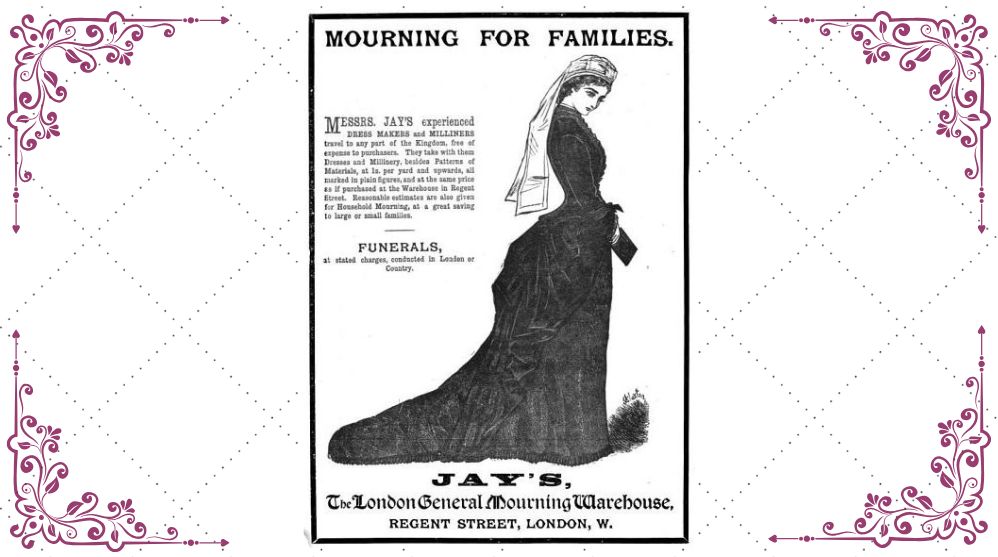
The Inconsolable Grief Department – shopping for mourning goods in Victorian times
- by Kate Bowman
- February 11, 2025
FASHIONABLE MOURNING AND THE HABILIMENTS OF GRIEF.
On the occasion of a recent visit to London, whilst I was debating with myself over the breakfast things as to how I should spend the day, I received by the post a letter deeply bordered with black, evidently a messenger of affliction. I tore the white weeping willow upon a black background which formed the device upon the seal, and read the contents. It proved to be an intimation from a relative of the sudden death of her brother-in-law, and a request that, under the circumstances of the sudden bereavement of the widow, I should undertake certain sad commissions relative to the articles of mourning required by the family. I at once set out upon my sad errand.
I had no difficulty in finding the maison de deuil to which I had been referred. It met me in the sad habiliments of woe; no vulgar colors glared from the shop windows, no gildings amazed with its festive brightness. The name of the firm scarce presumed to make itself seen in letters of the saddest gray upon a black ground. Here and there heads of white set off the general gloom of the house-front, like the crape piping of a widow’s cap. The very metal window frames and plates had gone into a decorous morning–zinc having taken the place of what we feel, under the circumstances, would have been quite out of the character: brass.
On pushing the plate glass door, it gave way with a hushed and muffled sound, and I was met by a gentlemen of sad expression, who, in the most sympathetic voice, inquired the nature of my want, and, on my explaining myself, directed me to the Inconsolable Grief Department. The interior of the establishment answered exactly to the appearance without. The long passage I had to traverse was paneled in white and black borderings, like so many mourning cards placed on end; and I was rapidly becoming impressed with the deep solemnity of the place, when I caught sight of a neat little figure rolling up some ribbon, who on my inquiring if I had arrived at the Inconsolable Grief Department, replied almost in a tone of gaiety, that that was the half-mourning counter, and that I must proceed further on until I had passed the repository for widow–silk.
Following her directions, I at last reached my destination–a large room draped in black with a hushed atmosphere about it as though somebody was lying invisible there in state. An attendant in sable habiliments, picked out with the inevitable white tie, and with an undertakerish eye and manner, awaited my commands, I produced my written directions. Scanning it critically, he said: “Permit me to inquire, sir, if it is a deceased partner?” I nodded assent. “We take the liberty of asking this distressing question,” he continued, “as we are extremely anxious to keep up the character of our establishment by matching, as it were, the exact shade of affliction. Our paramatta and crapes give satisfaction to the deepest woe. Permit me to show you a new texture of surprising beauty and elegance manufactured specially for this house, and which we call the inconsolable. Quite a novelty in the trade, I do assure you, sir.”
With this he placed a pasteboard box before me full of mourning fabrics.
“Is this it?” I inquired, lifting a lugubrious piece of draping.
“Oh, no!” he replied, “the one you have in your hand was manufactured for last year’s affliction, and was termed, ‘The Stunning Blow Shade.’ It makes up well, however, with our sudden bereavement silk- a leading article–and our distraction trimmings.”
“I fear,” said I, “my commission says nothing about these novelties.”
“Ladies in the country,” he blandly replied, “don’t know of the perfection to which the art of mourning genteelly has been brought! But I will see that your commission is attended to to the letter.”
Giving another glance over the list, he observed; “Oh! I perceive a widow’s cap is mentioned here, I must trouble you, sir, to proceed to the Weeds Department for that article–the first turning to the left.”
Proceeding, as directed, I came to a recess fitted up with a solid phalanx of widow’s caps. I perceived at a glance that they exhausted the whole gamut of grief, from the deepest shade to that tone which is expressive of a pleasing melancholy. The foremost row confronted me with the sad liveries of crapen folds, whilst those behind gradually faded off into light, ethereal tarleton, and one or two of the outsiders were even breaking out into worldly features and flaunting weepers. Forgetting the proprieties of the moment, I inquired of the grave attendant if one of the latter would be suitable.
“Oh! no, sir,” she replied with a slight shade of severity in the tone of her voice; “You may gradually work up to that in a year or two. But any of these,” pointing to the first row of widows’ weeds- -are suitable for the first burst of grief.”
Acquiescing in the propriety of this sliding scale of sorrow, I selected some weeds expressive of the deepest dejections I could find, and having completed my commission, inquired where I could procure for myself some lavender gloves.
“Oh! for those things, sir,” she said, in the voice of Tragedy speaking to Comedy, “you must turn to your right, and you will come to the Complimentary Mourning counter.”
Turning to the right, accordingly, I was surprised, and not a little shocked, to find myself amongst worldly colors. Tender lavender, I had expected; but violet, mauve, and even absolute red, stared me in the face. Thinking I had made a mistake, I was about to retire, when a young lady, in a cheerful tone of voice, inquired if I wanted anything in her department.
“I was looking for the Complimentary Mourning counter,” I replied, “for some gloves; but I fear I am wrong.”
“You are quite right, sir,” she observed. “This is it.”
She saw my eye glance at the cheerful colored silks, and with the instinctive tact of a woman guessed my thoughts in a moment. “Mauve, sir, is very appropriate for the lighter sorrows.”
“But absolute red!” I retorted, pointing to some velvet of that color.
“Is quite admissible when you mourn the departure of a distant relative. But allow me to show you some gloves?” and, suiting the action to the word, she lifted the cover from a tasteful glove box, and displayed a perfect picture of delicate half-tones, indicative of a struggle between the cheerful and the sad. “There is a pleasing melancholy in this shade of gray,” she remarked, indenting slightly each outer knuckle with the soft elastic kid as she measured my hand.
“Can you find lavender?”
“Oh, yes! but the sorrow tint is very slight in that; however, it wears admirably.”
Thus, by degrees, the grief of the establishment died out in tenderest lavender, and I took my departure deeply impressed with the charming improvements which Parisian taste has effected in the plain, old-fashioned style of English mourning.
The Christian Recorder 19 September 1863
Mrs Daffodil’s Aide-memoire: For more about the Byzantine conventions of Victorian mourning see Mourning Becomes Elective. For a look at a strange garden party at the London home of the Duke of Sutherland, promoting funeral reform and wicker-work coffins, see Wicker Man. The story “Crape” in the neo-Edwardian collection A Spot of Bother: Four Macabre Tales , tells of the revenge exacted from beyond the grave by an aunt determined to be “mourned relentlessly.” For further reading, see Mourning Dress: A Costume and Social History, by Lou Taylor.
The piece above appears in The Victorian Book of the Dead, by Chris Woodyard, also available in at bookshops worldwide and in a Kindle edition. It has been reproduced with permission from the author.
We hope you enjoyed reading something a bit different and took a moment to ponder the changes in social expectations of grief over time. Should you be interested to explore further, The Victorian Book of the Dead blog is full of delightful articles on the popular and material culture of Victorian death and mourning, featuring primary-source materials about corpses, crypts, and crape.
Author Chris Woodyard says, “I will also occasionally post on other funereal topics or share unique excerpts from primary sources. Some posts will be grim, some will be humourous, some grewsome, as the Victorians said. I will warn readers that I have a reprehensible penchant for treating the subject of death as entertainment.”
Image: A 1888 advertisement for Jay’s General Mourning Warehouse, London
Upcoming Events
- NOVEMBER 11, 2025
- 10:30 AM - 11:30 AM
Facts and fictions about wellbeing and volunteering
Wellbeing is a deeply personal experience, shaped by each individual’...
Read more- DECEMBER 2, 2025
- 10:00 AM - 12:00 PM
NSW Network of Managers of Palliative Care Volunteers – December meeting & Christmas lunch
The role of the Network is to ensure best practice for managers of palliati...
Read more- DECEMBER 3, 2025
- 9:30 AM - 1:30 PM
Safe Home Visiting – Training for Palliative Care Volunteer Managers
Safe Home Visiting will assist you to make your home visits productive and ...
Read moreBecome a member of Palliative Care NSW
Palliative Care New South Wales is the peak body in NSW representing palliative care providers and those with an interest in palliative care. Palliative Care New South Wales is a member of the national peak body Palliative Care Australia.
Join today and receive discounts, benefits and more!
Special member rate available for volunteers.
Subscribe to our eNews
Be the first to know our latest new, events, and research!
SUBSCRIBE TO ENEWS





